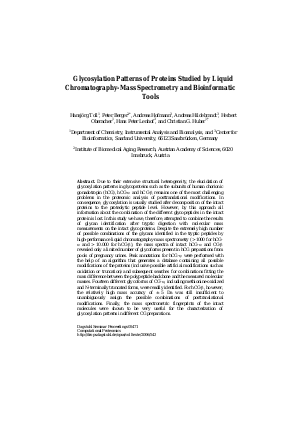Glycosylation Patterns of Proteins Studied by Liquid Chromatography-Mass Spectrometry and Bioinformatic Tools
Authors Hansjörg Toll, Peter Berger, Andreas Hofmann, Andreas Hildebrandt, Herbert Oberacher, Hans Peter Lenhof, Christian G. Huber
-
Part of:
Volume:
Dagstuhl Seminar Proceedings, Volume 5471
Part of: Series: Dagstuhl Seminar Proceedings (DagSemProc) - License:
 Creative Commons Attribution 4.0 International license
Creative Commons Attribution 4.0 International license
- Publication Date: 2006-05-03
File

PDF
DagSemProc.05471.8.pdf
- Filesize: 117 kB
- 6 pages
Document Identifiers
Subject Classification
Keywords
- Liquid chromatography
- mass spectrometry
- glycoproteins
- glycosylation
- peak annotation
Metrics
- Access Statistics
-
Total Accesses (updated on a weekly basis)
0Document
0Metadata
Abstract
Due to their extensive structural heterogeneity, the elucidation of glycosylation patterns in glycoproteins such as the subunits of chorionic gonadotropin (CG), CG-alpha and CG-beta remains one of the most challenging problems in the proteomic analysis of posttranslational modifications. In consequence, glycosylation is usually studied after decomposition of the intact proteins to the proteolytic peptide level. However, by this approach all information about the combination of the different glycopeptides in the intact protein is lost. In this study we have, therefore, attempted to combine the results of glycan identification after tryptic digestion with molecular mass measurements on the intact glycoproteins. Despite the extremely high number of possible combinations of the glycans identified in the tryptic peptides by high-performance liquid chromatography-mass spectrometry (> 1000 for CG-alpha and > 10.000 for CG-beta), the mass spectra of intact CG-alpha and CG-beta revealed only a limited number of glycoforms present in CG preparations from pools of pregnancy urines. Peak annotations for CG-alpha were performed with the help of an algorithm that generates a database containing all possible modifications of the proteins (inclusive possible artificial modifications such as oxidation or truncation) and subsequent searches for combinations fitting the mass difference between the polypeptide backbone and the measured molecular masses. Fourteen different glycoforms of CG-alpha, including methionine-oxidized and N-terminally truncated forms, were readily identified. For CG-beta, however, the relatively high mass accuracy of ± 2 Da was still insufficient to unambiguously assign the possible combinations of posttranslational modifications. Finally, the mass spectrometric fingerprints of the intact molecules were shown to be very useful for the characterization of glycosylation patterns in different CG preparations.
Cite As Get BibTex
Hansjörg Toll, Peter Berger, Andreas Hofmann, Andreas Hildebrandt, Herbert Oberacher, Hans Peter Lenhof, and Christian G. Huber. Glycosylation Patterns of Proteins Studied by Liquid Chromatography-Mass Spectrometry and Bioinformatic Tools. In Computational Proteomics. Dagstuhl Seminar Proceedings, Volume 5471, pp. 1-6, Schloss Dagstuhl – Leibniz-Zentrum für Informatik (2006)
https://doi.org/10.4230/DagSemProc.05471.8
BibTex
@InProceedings{toll_et_al:DagSemProc.05471.8,
author = {Toll, Hansj\"{o}rg and Berger, Peter and Hofmann, Andreas and Hildebrandt, Andreas and Oberacher, Herbert and Lenhof, Hans Peter and Huber, Christian G.},
title = {{Glycosylation Patterns of Proteins Studied by Liquid Chromatography-Mass Spectrometry and Bioinformatic Tools}},
booktitle = {Computational Proteomics},
pages = {1--6},
series = {Dagstuhl Seminar Proceedings (DagSemProc)},
ISSN = {1862-4405},
year = {2006},
volume = {5471},
editor = {Christian G. Huber and Oliver Kohlbacher and Knut Reinert},
publisher = {Schloss Dagstuhl -- Leibniz-Zentrum f{\"u}r Informatik},
address = {Dagstuhl, Germany},
URL = {https://drops.dagstuhl.de/entities/document/10.4230/DagSemProc.05471.8},
URN = {urn:nbn:de:0030-drops-5431},
doi = {10.4230/DagSemProc.05471.8},
annote = {Keywords: Liquid chromatography, mass spectrometry, glycoproteins, glycosylation, peak annotation}
}
